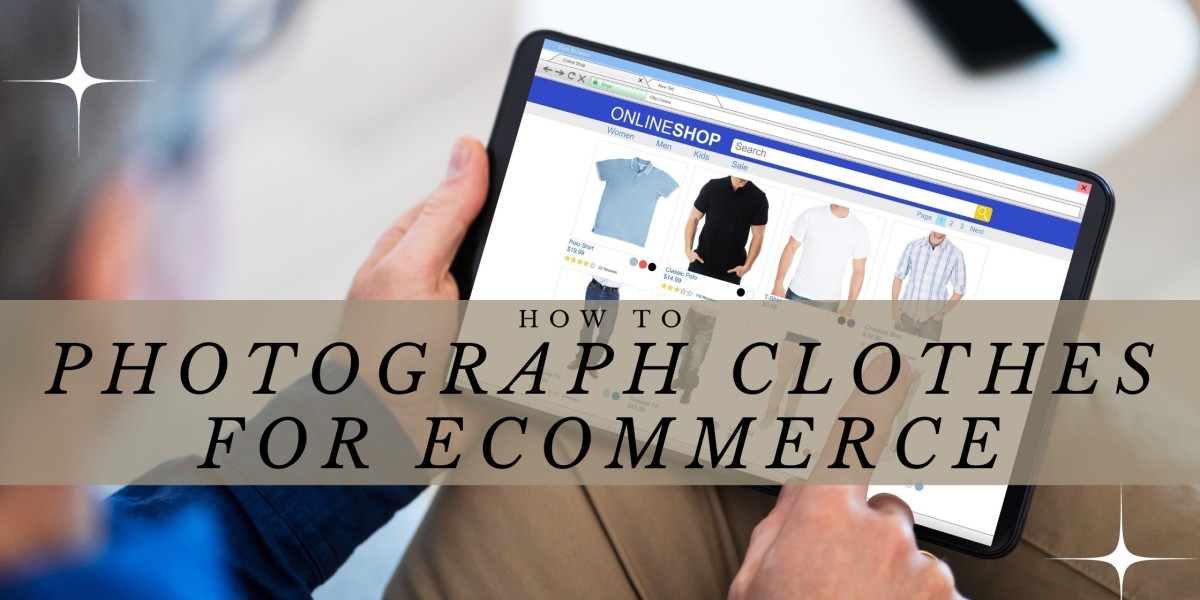In today's fast-paced world of e-commerce, where a plethora of options is just a click away, the importance of eye-catching visuals cannot be overstated. This is especially true when it comes to clothing, as potential buyers want to see every aspect of the product before making a purchase decision. In this extensive guide, we'll delve into the art of capturing compelling clothing photos for your e-commerce business, equipping you with tips and techniques that will make your products shine online.
Understanding the Crucial Role of Quality Clothing Photos
Before we dive into the specifics of clothing photography, it's imperative to grasp why high-quality clothing photos are paramount for your e-commerce success.
The Visual Appeal - A Shopper's First Impression
In the digital realm of online shopping, your product images serve as your storefront. Just as a well-designed physical store can attract customers, visually appealing photos can draw online shoppers in. The first impression is often visual, and enticing images can captivate potential customers, compelling them to explore your offerings further.
Building Trust through Transparency
In the absence of physical interaction with the product, customers rely heavily on what they can see. High-quality photos create transparency by providing a clear and detailed view of your clothing items. When customers see what they are getting, they are more likely to trust your brand, leading to reduced returns and increased satisfaction.
Gaining a Competitive Edge
In the vast expanse of online retail, competition is fierce. The quality of your product photos can set you apart from the crowd. Exceptional photos not only showcase your products in the best light but also demonstrate your commitment to excellence. This can give your brand a significant competitive edge.
Choosing the Right Equipment
Now that we understand the importance of high-quality clothing photos, let's delve into the essential tools you need to get the job done right.
Camera Selection - The Foundation of Quality
Investing in a good digital camera is the first step. While modern smartphones have impressive cameras, a dedicated digital camera with manual settings provides greater control over your photos. DSLRs (Digital Single-Lens Reflex) and mirrorless cameras are favored choices among professional photographers.
Lens Selection - The Art of Focus and Background Blur
Selecting the right lens is just as vital as choosing the camera itself. For clothing photography, a prime lens with a wide aperture (such as f/1.8 or f/2.8) works wonders. This type of lens allows you to achieve that beautiful background blur, known as bokeh, while keeping the clothing in sharp focus.
Tripod - The Stability Factor
Stability is key for sharp, professional-looking photos. Even the steadiest hand can introduce slight camera shake, which is especially noticeable in close-up shots. Invest in a sturdy tripod to eliminate this issue. This is crucial when shooting in low-light conditions or using slow shutter speeds.
Lighting - Illuminating Your Subject
Proper lighting can make or break your clothing photos. While natural light is ideal, it's not always available or consistent. For indoor photography, consider investing in softbox lights or ring lights. These tools provide even, diffused lighting that minimizes harsh shadows and highlights.
Setting Up Your Clothing Photography Studio
Creating a dedicated space for clothing photography ensures consistency and efficiency in your workflow.
The Background - A Blank Canvas
Choose a neutral background that won't distract from the clothing. A plain white or gray backdrop is a classic choice. You can use paper rolls, fabric, or collapsible background panels for this purpose. Keep it clean and wrinkle-free to maintain a professional look.
Mannequins or Models - Bringing Clothes to Life
Decide whether you'll use mannequins or models to display your clothing. Mannequins are excellent for showcasing the fit and shape of the garments, allowing customers to visualize how the clothes will drape on a body. On the other hand, models add a human touch and can help customers envision themselves wearing the clothing.
Setup and Styling - The Devil's in the Details
Carefully arrange and style the clothing before you start shooting. Make sure it's wrinkle-free and looks its best. Use clothing clips and pins to achieve the desired fit and shape. Pay attention to details like collar alignment, buttoning, and accessories. Every element in the frame should contribute to making the clothing look its finest.
The Mannequin Effect - Adding Dimension
To create a sense of dimension and fit, consider using the "mannequin effect" technique. This involves dressing a mannequin in the clothing and then digitally removing the mannequin during post-processing. The result is an image that showcases the clothing in a lifelike manner, displaying how it would appear when worn.
Mastering Camera Settings
With your studio ready, it's time to master the camera settings that will help you capture stunning clothing photos.
Aperture (f-stop) - Controlling Depth of Field
Set your camera's aperture to a low value (e.g., f/2.8) to create a shallow depth of field. This technique blurs the background, keeping the focus on the clothing itself. It's a popular choice for fashion photography as it separates the subject from its surroundings, making it stand out.
Shutter Speed - Freeze the Action
Maintain a fast shutter speed to avoid motion blur. When photographing clothing, you want every detail to be crisp and clear. A shutter speed of 1/125th of a second or faster is a good starting point. Adjust it as needed to suit your specific conditions.
ISO - Controlling Sensitivity to Light
Keep the ISO as low as possible to minimize noise in your photos. Start at ISO 100, as it offers the cleanest image quality. Increase the ISO only if you need to compensate for low light conditions. However, be cautious, as higher ISO settings can introduce digital noise.
White Balance - Accurate Colors
Set the white balance according to your lighting conditions. Most cameras offer presets like "Daylight," "Tungsten," or "Fluorescent." Alternatively, you can manually adjust the color temperature to achieve accurate colors. Proper white balance ensures that the clothing's colors are faithful to reality.
Shooting in RAW - More Data, More Control
Capture your photos in RAW format if your camera supports it. RAW files retain more information compared to JPEGs, allowing for better post-processing. They give you greater control over exposure, color correction, and other adjustments during the editing phase.
Composing Your Clothing Photos
Composition is the art of arranging elements within your frame to create visually pleasing images.
Rule of Thirds - Balancing Your Composition
Use the rule of thirds as a guideline for positioning your clothing within the frame. Imagine the frame divided into thirds both horizontally and vertically, creating a grid. Place key elements along these lines or at their intersections. This off-center placement often results in more visually engaging photos.
Angles and Perspectives - Exploring Creativity
Experiment with different angles and perspectives. Don't limit yourself to shooting straight on. Capture your clothing from above, at eye level, or from a low angle to showcase it from various viewpoints. This variety of angles adds depth and visual interest to your photos.
Fill the Frame - Emphasizing Details
When photographing clothing, aim to fill the frame with your subject. This means leaving little empty space around the clothing item. Doing so allows customers to see the details up close, making your product more enticing.
Multiple Shots - Comprehensive Coverage
Capture multiple shots of each clothing item. Highlight different features or angles to provide customers with a comprehensive view of the product. Include shots from the front, back, sides, and close-ups of important details like stitching, buttons, and fabric texture.
Editing and Retouching
Even the best photos can benefit from a bit of post-processing to make them truly pop.
Editing Software - Unleashing Your Creativity
Invest in photo editing software like Adobe Lightroom or Photoshop. These tools offer powerful editing capabilities and can significantly enhance your photos. They allow you to fine-tune exposure, color balance, and other aspects of your images.
Adjust Exposure - Enhancing Overall Look
During the editing process, focus on adjusting exposure, contrast, and brightness to make your clothing items stand out. Ensure that the overall image is well-balanced and visually appealing. Correct any color issues and remove any distractions in the background.
Retouching - Perfection in Post-Production
Use retouching techniques to remove imperfections or blemishes from the clothing. This might include eliminating wrinkles, stray threads, or minor stains. Ensure that colors are accurate and consistent across all photos of the same product, providing customers with a reliable representation.
Image Resizing - Optimizing for the Web
Before uploading your photos to your e-commerce website, resize them to ensure fast loading times. Large image files can slow down your site, which can frustrate visitors and potentially lead to abandoned carts. Find the right balance between image quality and file size to optimize the user experience.
Showcasing Your Photos on Your E-commerce Site
With your stunning clothing photos ready, it's time to effectively showcase them on your e-commerce platform.
High-Resolution Images - Enabling Zoom and Detail
Upload high-resolution images to your website to provide customers with the ability to zoom in and examine the clothing in intricate detail. High-quality visuals instill confidence in your products, as customers can see every stitch and texture up close.
Image Galleries - Offering Multiple Views
Create image galleries for each clothing item, allowing customers to scroll through multiple photos. Include shots from various angles and close-ups of significant details. Provide a 360-degree view or a combination of images that showcase the item's versatility.
Zoom Feature - Mimicking In-Store Examination
Implement a zoom feature on your website that enables users to magnify specific areas of the clothing. This feature enhances the online shopping experience by allowing customers to inspect the fabric, stitching, and finer details as they would in a physical store.
Consistency - Brand Identity Matters
Maintain a consistent style and format for your clothing photos. Consistency creates a cohesive and professional look on your e-commerce website. Use the same background, lighting setup, and editing style across all your product images. This not only reinforces your brand identity but also enhances the overall shopping experience for your customers.
Conclusion
In the competitive landscape of e-commerce, the power of visual content is undeniable. When it comes to selling clothing online, high-quality photos are your secret weapon. They attract customers, build trust, and give your brand a competitive edge. By investing in the right equipment, setting up a dedicated studio, mastering camera settings, composing your shots thoughtfully, and applying post-processing techniques, you can capture clothing photos that truly shine in the online marketplace. So, gear up, get creative, and watch your e-commerce business flourish with captivating clothing photography. Remember, a picture is worth a thousand words, and in e-commerce, it might also be worth a thousand sales. With the added "mannequin effect," your clothing will come to life, showcasing its fit and form in the most enticing manner possible.









